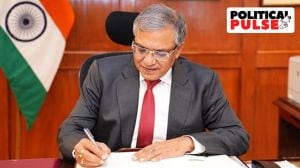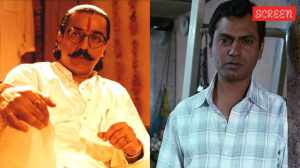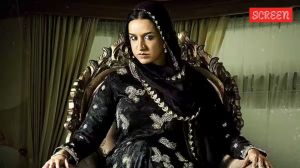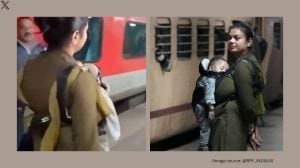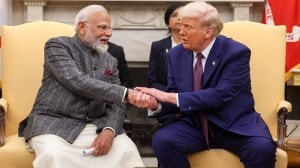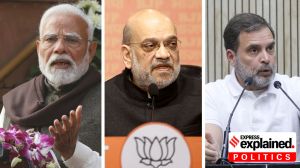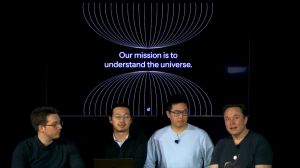UPSC Key: AI action summit, Fiscal Health Index, and Election Integrity Index
Why Fiscal Health Index is relevant to the UPSC exam? What is the significance of topics such as ISRO's Navigation satellite, Iron Age, and India-Indonesia relationship on both the preliminary and main exams? You can learn more by reading the Indian Express UPSC Key for January 25, 2025.
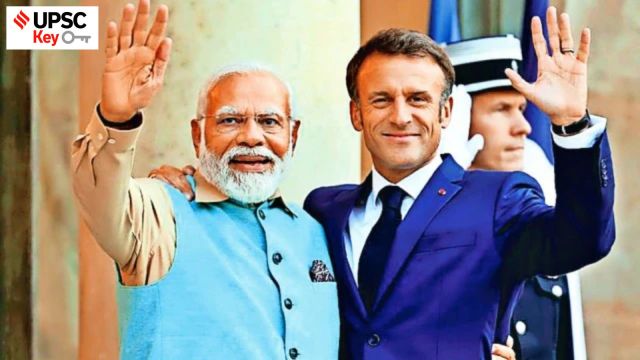 Prime Minister Narendra Modi is set to make a state visit to France and then participate in the AI Summit to be held here in February. (File photo)
Prime Minister Narendra Modi is set to make a state visit to France and then participate in the AI Summit to be held here in February. (File photo)Important topics and their relevance in UPSC CSE exam for January 25, 2025. If you missed the January 24, 2025 UPSC CSE exam key from the Indian Express, read it here
FRONT
PM Modi to visit Paris Feb 10-11 to co-chair AI action summit
Syllabus:
Preliminary Examination: Current events of national and international importance
Mains Examination: General Studies-II: Bilateral, regional and global groupings and agreements involving India and/or affecting India’s interests
What’s the ongoing story: Prime Minister Narendra Modi will travel to Paris on February 10 and 11 to co-chair the Artificial Intelligence (AI) Action Summit hosted by France.
Key Points to Ponder:
• What are the ethical issues related to AI?
• What are the initiatives taken by India to integrate AI?
• What is the purpose of the AI action summit?
• What are the challenges related to AI?
• What are the important bilateral cooperation signed by India to promote AI?
• What are the various applications of AI?
• What are the challenges of AI?
Key Takeaways:
• This will be Modi’s first visit to France in his third term, and a possible opportunity to meet US President Donald Trump if he, too, attends the AI summit. India will also hold bilateral engagements with President Macron and other leaders attending the summit.
• The AI Action Summit, to be held at the Grand Palais, will be attended by Heads of State, leaders of international organisations, CEOs of small and large companies, academics, non-governmental organisations, artists and civil society members.
• France is looking to build on the momentum generated by the UK and South Korea, which had organised the previous two summits in November 2023 and May 2024, respectively.
• The Paris Summit, which is campaigning for “ethical, sustainable and inclusive AI”, will focus on five “main pillars” forming the basis of the preparatory work.
• The first is “AI in the service of the general interest” or “the public interest”. The second is “the future of work” based on the principle that “the integration of artificial intelligence is transforming labour markets, job content, tasks and ways of working”.
• The third pillar is “innovation and culture”, with the aim to “boost technological excellence in the service of innovation and artistic creation”. The fourth pillar is “trusted artificial intelligence”. And finally, the “global governance of AI”, the last point stemming from the four previous pillars.
Do You Know:
• On the second day of his presidency, Donald Trump announced billions of dollars worth of investment to build artificial intelligence infrastructure in the United States of America.
• The Stargate Project is essentially a new company that aims to invest $500 billion towards building advanced AI infrastructure in the US over the next four years. The initiative will invest $100 billion almost immediately. This ambitious project seeks to push American AI leadership, create hundreds of thousands of jobs, and provide significant global economic benefits.
• Maharashtra’s minister of Information and Technology Ashish Shelar on Friday declared that Maharashtra will become the first state in India to establish an Artificial Intelligence University.
Other Important Articles Covering the same topic:
📍Maharashtra to launch India’s first AI University
📍Donald Trump unveils $500 billion Stargate Project
Previous year UPSC Prelims Question Covering similar theme:
(1) With the present state of development, Artificial Intelligence can effectively do which of the following? (UPSC CSE 2020)
1. Bring down electricity consumption in industrial units
2. Create meaningful short stories and songs
3. Disease diagnosis
4. Text-to-Speech Conversion
5. Wireless transmission of electrical energy
Select the correct answer using the code given below:
(a) 1, 2, 3 and 5 only
(b) 1, 3 and 4 only
(c) 2, 4 and 5 only
(d) 1, 2, 3, 4 and 5
Previous year UPSC Mains Question Covering similar theme:
Introduce the concept of Artificial Intelligence (AI). How does Al help clinical diagnosis? Do you perceive any threat to privacy of the individual in the use of Al in healthcare? (UPSC CSE 2023)
ECONOMY
Competitive populism, climate change to increase fiscal pressure on states: NITI Aayog officials
Syllabus:
Preliminary Examination: Economic and Social Development – Sustainable Development, Poverty, Inclusion, Demographics, Social Sector Initiatives, etc.
Mains Examination: General Studies-III: Indian Economy and issues relating to planning, mobilisation, of resources, growth, development and employment
What’s the ongoing story: Odisha, Chhattisgarh, and Jharkhand led NITI Aayog’s new Fiscal Health Index on the back of mining-linked premiums, whereas Punjab, Andhra Pradesh, and West Bengal emerged as major laggards across parameters including revenue mobilisation and fiscal prudence.
Key Points to Ponder:
• What is the purpose of the Fiscal Health Index?
• What is the significance of effective capital expenditure strategies to obtain optimum utilisation of resources in the economy?
• What are the challenges faced by states in their resource management?
• What is the significance of fiscal responsibility?
• Learn about the terms: Market equilibrium, Elasticity of demand and supply, fiscal policy, and monetary policy
Key Takeaways:
• During the report launch on Friday, officials at India’s apex think tank flagged the impact of subsidies and competitive populism on quality of expenditure, and stressed that climate change will increase fiscal pressure on states.
• Covering 18 major states for the financial year 2022-23, the index assigned a score to each state on the basis of five parameters – quality of expenditure, revenue mobilisation, fiscal prudence, debt index, and debt sustainability. Odisha led overall, followed by Chhattisgarh, Goa, Jharkhand, and Gujarat.
• Punjab emerged as the biggest laggard, followed by Andhra Pradesh, West Bengal, Kerala, and Haryana. “Kerala and Punjab struggle with low quality of expenditure and debt sustainability, while West Bengal faces revenue mobilization and debt index issues. Andhra Pradesh has high fiscal deficits, and Haryana has a poor debt profile,” it said.
• In quality of expenditure, Madhya Pradesh scored the highest with 59.7 points from 100, followed by Bihar and Chhattisgarh.
• He added that much of the investment needed for climate change is going to be at the state level, and that think-tank is working on financing a big investment push for states.
Do You Know:
• The GDP is essentially the monetary measure of all the goods and services produced within India’s borders in a year. It provides the size of the Indian economy.
• The nominal GDP is what is used to arrive at the US dollar equivalent figure for the size of the Indian economy. At an exchange rate of 85 rupees to a dollar, India’s GDP in FY25 will be $3.8 trillion.
• It is noteworthy that if India’s exchange rate had not fallen from around 61 rupees to a dollar in 2014 then today India could have boasted of becoming a $5 trillion economy ($5.3 trillion to be exact).
• The real GDP is derived by removing the effect of inflation from nominal GDP. The nominal GDP of a country can go up either because the country produces more goods and services or because the prices of existing goods and services have gone up (read inflation). More often than not, both these factors lead to an increase in GDP.
• The real GDP tells the extent to which India produced more goods and services and it does so by removing the prices at which goods and services are pegged.
Other Important Articles Covering the same topic:
📍ExplainSpeaking: What the latest GDP estimates tell about the state of India’s economy
📍Behind India’s economic slowdown, our very own Deep State
Previous year UPSC Prelims Question Covering similar theme:
(2) With reference to Indian economy, demand-pull inflation can be caused/ increased by which of the following? (UPSC CSE 2021)
1. Expansionary policies
2. Fiscal stimulus
3. Inflation-indexing wages
4. Higher purchasing power
5. Rising interest rates
Select the correct answer using the code given below.
(a) 1, 2 and 4 only
(b) 3, 4 and 5 only
(c) 1, 2, 3 and 5 only
(d) 1, 2, 3, 4 and 5
GOVT & POLITICS
CEC: Time for poll mgmt bodies to devise ‘election integrity index’
Syllabus:
Preliminary Examination: Indian Polity and Governance – Constitution, Political System, Panchayati Raj, Public Policy, Rights Issues
Mains Examination: General Studies-II: Appointment to various Constitutional posts, powers, functions and responsibilities of various Constitutional Bodies.
What’s the ongoing story: Chief Election Commissioner Rajiv Kumar on Friday said it was time for election management bodies (EMBs) to come up with their own “election integrity index”, while raising concern over existing democracy indices becoming tools to discredit elections.
Key Points to Ponder:
• What is the role of the Election Commission of India (ECI)?
• How elections are conducted at different levels in India?
• Why voter participation is important for a democracy?
• What are the constitutional articles related to the ECI?
• What are the new-age challenges faced by the ECI?
Key Takeaways:
• “It is also time for EMBs to devise and demand transparency in the parameters which are used for indices, maybe this is one area for deliberations in future,” Kumar said. He said indices should take into account the way the election was conducted, if voters could register freely, if there were any restrictions on them from coming out to vote among other things.
• The CEC also flagged the threat of “external influences” through “cyber interference and disinformation” facing EMBs today. He said while social media platforms had democratised access to information, they had also become tools to destroy the core of democracy. He said “anti-pollution measures” were needed for social media — algorithms can be used to detect fake news and stop its circulation.
Do You Know:
• The Constitution has the following articles (Articles 324–329) to empower the Election Commission and provide insight into the potential roles and functions of the commission.
• Article 324: The superintendence, direction and control of the preparation of the electoral rolls for, and the conduct of, all elections to Parliament and the Legislature of every state and of elections to the offices of President and Vice-President.
• Article 325: No individual to be excluded from electoral rolls on the basis of religion, race, caste, sex or any of them.
• Article 326: Adult suffrage shall be the basis for elections to the House of the People and to the Legislative Assemblies of States.]
• Article 327: Parliament may, according to the provisions of this Constitution, from time to time enact laws with respect to all matters relating to elections to Parliament and Legislative Assemblies of States.
• Article 328: A state’s Legislature may from time to time by law make provision with respect to all matters relating to, or in connection with, the elections to the House or either House of the Legislature.
• Article 329: The article prohibits the courts from becoming involved in electoral matters.
Other Important Articles Covering the same topic:
📍What is the relevance of the National Voters’ Day for UPSC exam
📍What the global media fails to understand about India’s democracy
Previous year UPSC Prelims Question Covering similar theme:
(3) Consider the following statements: (UPSC CSE 2017)
1. The Election Commission of India is a five-member body.
2. Union Ministry of Home Affairs decides the election schedule for the conduct of both general elections and bye-elections.
3. Election Commission resolves the disputes relating to splits/mergers of recognised political parties.
Which of the statements given above is/are correct?
(a) 1 and 2 only
(b) 2 only
(c) 2 and 3 only
(d) 3 only
EXPRESS NETWORK
ISRO launch No. 100 is Nav Sat equipped with atomic clocks developed in India
Syllabus:
Preliminary Examination: Current events of national and international importance
Mains Examination: General Studies-III: Science and Technology- developments and their applications and effects in everyday life.
What’s the ongoing story: In its 100th launch, the Indian Space Research Organisation (ISRO) is geared to send off a 2,250-kg navigation satellite on-board GSLV-F15 from Sriharikota on January 29 at 06.23 am, the space agency said.
Key Points to Ponder:
• What is IRNSS? What is its significance?
• What are the important ISRO’s missions?
• What is the atomic clock?
• What is the Global Positioning System (GPS)?
• What are the challenges of developing an independent navigation constellation?
Key Takeaways:
• The NVS-02 is the second of the five second-generation satellites developed by the space agency to replace the existing satellites in the country’s navigation constellation Indian Regional Navigation Satellite System.
• The new generation of satellites have a longer lifespan of 12 years and are also equipped with indigenously developed, more accurate atomic clocks. The new generation of satellites also utilise L1 frequency, which is most commonly used in the US Global Positioning System (GPS), and is likely to lead to more utilisation by smaller devices such as fitness trackers.
• The launch on January 29 will be the 17th flight of the GSLV vehicle, with the 11th flight using the indigenously developed cryogenic engine.
• IRNSS — sometimes referred to as NavIC or Navigation with Indian Constellation — is a seven satellite system that provides positioning, navigation and timing services over the Indian mainland and 1,500 km in its neighbourhood.
• The first satellite in the constellation IRNSS-1A was launched in 2013, with a mission life of 10 years. The next two satellites IRNSS-1B and 1C were launched in the subsequent years. Replacements were needed for some of the satellites in the constellation even before the end of their mission life since the atomic clocks on-board the satellites malfunctioned.
• A satellite-based positioning system determines the location of objects by accurately measuring the time it takes for a signal to travel to and from it using the atomic clocks on board.
Do You Know:
• The IRNSS is an independent regional navigation satellite system developed by India. It is designed to provide accurate position information service to assist in the navigation of ships in the Indian Ocean waters.
• The Maritime Safety Committee (MSC) of the IMO recognised the IRNSS as a component of the World-wide Radio Navigation System (WWRNS).
• With the recognition as a component of the of the WWRNS, the Indian navigation system is similarly placed as GPS, most commonly used by marine shipping vessels across the world or the Russian Global Navigation Satellite System (GLONASS).
• After the US, Russia and China that have their own navigation systems, India has become the fourth country to have its independent regional navigation system. Unlike GPS, however, IRNSS is a regional and not a global navigation system.
Other Important Articles Covering the same topic:
📍Explained: What is the new regional navigation satellite system or IRNSS?
Previous year UPSC Prelims Question Covering similar theme:
(4) With reference to the Indian Regional Navigation Satellite System (IRNSS), consider the following statements: (UPSC CSE 2018)
1. IRNSS has three satellites in geostationary and four satellites in geosynchronous orbits.
2. IRNSS covers entire India and about 5500 sq. km beyond its borders.
3. India will have its own satellite navigation system with full global coverage by the middle of 2019.
Which of the statements given above is/are correct?
(a) 1 only
(b) 1 and 2 only
(c) 2 and 3 only
(d) None
Previous year UPSC Mains Question Covering similar theme:
What do you understand by ‘Standard Positioning Systems’ and ‘Precision Positioning Systems’ in the GPS era ? Discuss the advantages India perceives from its ambitious IRNSS programme employing just seven satellites.
Iron Age began in Tamil Nadu hundreds of years earlier than believed: Study
Syllabus:
Preliminary Examination: History of India and Indian National Movement
Mains Examination: General Studies-I: Indian culture will cover the salient aspects of Art Forms, literature and Architecture from ancient to modern times
What’s the ongoing story: In an announcement that challenges long-held assumptions about the origins of the Iron Age, a new study has found evidence that the use of iron in the area that is now Tamil Nadu dates back to the first quarter of the 4th millennium BCE. This revelation, based on rigorous radiometric dating from multiple international laboratories, positions the region as a pioneering hub of early metallurgy, surpassing global timelines by nearly two millennia.
Key Points to Ponder:
• What is the Iron Age? Why is it called Iron Age?
• What are the various pre-historical periods in the history of India?
• What are the characteristics and features of the Iron Age?
• What is the significance of the Iron Age?
• How Iron Age is different from the Copper Age?
• What is the Indus Valley Civilisation?
Key Takeaways:
• The findings were produced in a report titled ‘Antiquity of Iron: Recent Radiometric Dates from Tamil Nadu’, authored by K Rajan and R Sivanantham.
• The findings, which provide evidence that iron technology in Tamil Nadu dates as far back as 3345 BCE, are supported by Accelerator Mass Spectrometry (AMS) and Optically Stimulated Luminescence (OSL) analyses conducted on samples from archaeological sites such as Sivagalai, Adichanallur, Mayiladumparai, and Kilnamandi.
• Until recently, the Iron Age in India was believed to have emerged between 1500 and 2000 BCE, closely following the Indus Valley Civilisation. However, new data from Tamil Nadu pushes this timeline further back.
• A paddy sample from a burial urn in Sivagalai was dated to 1155 BCE, while charcoal and potsherds (broken pieces of ceramic material) from the same site provided dates ranging from 2953 BCE to 3345 BCE, making it the earliest recorded evidence of iron technology globally.
• It also establishes that Tamil Nadu was not merely a participant in the evolution of metallurgy but an innovator, as the smelted iron findings have been dated to the middle of the third millennium BCE for the first time in the world, altering the understanding of global cultural trajectories.
 Three types of iron-smelting furnaces were identified at Kodumanal, Chettipalayam, and Perungalur, showcasing early innovations in extracting iron.
Three types of iron-smelting furnaces were identified at Kodumanal, Chettipalayam, and Perungalur, showcasing early innovations in extracting iron.
• Archaeological sites in Tamil Nadu also revealed varied metallurgical techniques. Three types of iron-smelting furnaces were identified at Kodumanal, Chettipalayam, and Perungalur, showcasing early innovations in extracting iron.
• Globally, the Iron Age has long been attributed to the Hittite Empire in Anatolia, where iron technology is believed to have emerged around 1300 BCE. However, the Tamil Nadu findings challenge this.
Do You Know:
• The Indus Civilisation, which reached its zenith between 2600 and 1900 BCE, sprawled over more than 800,000 sq km in what is today Pakistan and parts of northwestern India. It was the world’s most sophisticated urban culture at the time, with an elaborate system of trade, taxation, and drainage.
Other Important Articles Covering the same topic:
📍Naming the oldest civilisation of India
Previous year UPSC Prelims Question Covering similar theme:
(5) With reference to the difference between the culture of Rigvedic Aryans and Indus Valley people, which of the following statements is/are correct? (UPSC CSE 2017)
1. Rigvedic Aryans used the coat of m ail an d h el met in warfare whereas the people of Indus Valley Civilization did not leave any evidence of using them.
2. Rigvedic Aryans knew gold, silver am copper whereas Indus Valley people knew only copper and iron.
3. Rigvedic Aryans had domesticated the horse whereas there is no evidence of Indus Valley people having been aware of this animal.
Select the correct answer using the code given below:
(a) 1 only
(b) 2 and 3 only
(c) 1 and 3 only
(d) 1, 2 and 3
EDITORIAL
A lot done, more to do
Syllabus:
Preliminary Examination: Indian Polity and Governance – Constitution, Political System, Panchayati Raj, Public Policy, Rights Issues
Mains Examination: General Studies-I: Constitution of India —historical underpinnings, evolution, features, amendments, significant provisions and basic structure
What’s the ongoing story: S Ravindra Bhat writes: Emerging from colonial rule, India that is Bharat saw its people transform into empowered citizens, putting together its Constitution, a full-fledged democracy with universal adult franchise. This bold assertion of the nation’s democratic identity was in the wake of unparallelled sectarian violence.
Key Points to Ponder:
• What does our Constitution, and governance system mean to the weakest, most disempowered people, whose voices are mostly unheard?
• What are the challenges facing the judiciary system in India?
• Prosperity and well-being cannot be measured by gross national wealth, but the net feeling of well-being of each individual. Discuss.
• What are the principles embodied in the Indian constitution?
• How does the Constitution guarantee dignity, justice (including social and economic) and fraternity?
Key Takeaways:
• The Constitution held out the promise of social justice, of distribution of material resources for the good of the greatest number. Our birthright, our swaraj, was not only independence from the external ruler, but also the resolve to economically and socially emancipate our citizens.
• At this 75th anniversary of our republic, there is much to celebrate. From 32 years, the average life expectancy of citizens is now 75 years. India has become one of the largest producers of foodgrains.
• Literacy rate has increased from 12 per cent to 75 per cent. In power generation, road and infrastructure development, we have made major strides. In size, our nation has the fifth largest economy globally. Our forays into space have shown spectacular success, with the soft landing of Chandrayaan-3’s Vikram.
• The Constitution guarantees dignity, justice (including social and economic) and fraternity, besides liberty. This guarantee of dignity and fraternity constitutes the essence of our basic rights, where individuals are bound to value each other’s worth.
• This places greater responsibility on the state to ensure that each policy and law achieves the objective of meaningful access to education, public health, employment and a basic standard of living assuring self-worth and dignity to each citizen.
• Assuring dignity involves going beyond providing basic human needs. It entails a commitment by the state and society to ensure what we have not achieved.
• True dignity and fraternity means the practice of an attitude which we have not yet displayed: That every human being is capable of doing everything; that the poorest and the weakest are equal in worth and as secure with full rights as citizens as any other.
• The legal world, which I have been a part of, needs to be reimagined. There is much to be desired in terms of realising the goal of quick and inexpensive justice.
• There is an urgent need to develop long term plans to address the systemic challenges of the court system, be it infrastructure, identification of causes for case arrears, optimal caseload of judges.
• India is currently experiencing its own digital revolution impacting everyday life — from petty transactions or access to banking facilities, to online retail marketplaces and access to education.
• What has undoubtedly propelled the nation in terms of progress, also carries with it the perils of exclusion — exacerbated by geographical limitations, limited individual spending capacities, and low levels of digital literacy. This “digital divide” has rendered millions vulnerable, with regards to their rights, entitlements and access to essential services.
• Lastly, efforts towards mitigating the disastrous impact of climate change on our geographically diverse and vast territory is the need of the hour.
• Prosperity and well-being cannot be measured by gross national wealth, but the net feeling of well-being of each individual. Existing barriers, “narrow domestic walls”, have to go.
Do You Know:
• According to a written reply by Law Minister Arjun Ram Meghwal on a question by JDU MP Sanjay Kumar Jha in Novemebr 2024, there are two vacancies in the SC, 364 in the high courts and 5,245 in lower courts across states.
• For an estimated population of 1.4 billion or 140 crore people, the sanctioned strength of judges overall is just 25,081. There are a significant number of vacancies at any given time and for the available judges, there are a little over 20,000 court rooms.
Other Important Articles Covering the same topic:
📍Judiciary has more than 5,600 vacancies across courts
📍The judiciary is slow and clogged — it’s time to get outside help to fix it
Previous year UPSC Prelims Question Covering similar theme:
(6) Which one of the following factors constitutes the best safeguard of liberty in a liberal democracy? (UPSC CSE 2021)
(a) A committed judiciary
(b) Centralization of powers
(c) Elected government
(d) Separation of powers
Previous year UPSC Mains Question Covering similar theme:
‘Constitutional Morality’ in rooted in the Constitution itself and is founded on its essential facets. Explain the doctrine of ‘Constitutional Morality’ with the help of relevant judicial decisions. (UPSC CSE 2021)
Beyond the China factor
Syllabus:
Preliminary Examination: Current events of national and international importance
Mains Examination: General Studies-II: India and its neighbourhood- relations, and Bilateral, regional and global groupings and agreements involving India and/or affecting India’s interests.
What’s the ongoing story: Gurjit Singh writes: A key outcome of Indonesian President Prabowo Subianto’s visit to India is likely to be the establishment of a broader and more strategic partnership between the two nations.
Key Points to Ponder:
• What is the significance of the Indo-Pacific for India?
• Why is BRICS expanding its membership?
• What is the “ASEAN Plus” policy?
• What is the Indian Ocean Rim Association (IORA)?
• What is the significance of the Bay of Bengal Initiative for Multi-Sectoral Technical and Economic Cooperation (BIMSTEC)?
• How can India leverage its position with the South East Asian countries?
• Know about the historical background, area of cooperation and conflict between India and Indonesia.
Key Takeaways:
• While India and Indonesia do not always share identical worldviews or voting patterns in forums such as the United Nations, their increasing engagement has paved the way for a more coherent partnership. Prabowo, like Modi, is determined to elevate his country’s global stature. A critical challenge lies in how Jaishankar builds a rapport with Indonesia’s new foreign minister, Sugiono.
• Indonesia’s membership of BRICS, granted in 2023, presents another avenue for collaboration. Much like India and Brazil on BRICS’ platforms, India and Indonesia can leverage their partnership to bring strategic heft to this bloc.
• Another potential area is the development of trilateral partnerships. India and Indonesia, alongside Australia, already have a trilateral framework, though it lacks substantial content.
• India and Indonesia can also engage more directly on how the ASEAN-plus-one, East Asia Summit (EAS) and ASEAN Regional Forum (ARF) meetings progress. Both should have prior consultations to make a meaningful impact on such regional architecture.
• Indonesia should be invited to join the Bay of Bengal Initiative for Multi-Sectoral Technical and Economic Cooperation (BIMSTEC) to integrate it better with India’s eastern neighbourhood.
• Leveraging platforms such as BRICS, the IPOI, and trilateral frameworks with Australia and Japan, both India and Indonesia can forge a deeper partnership. While differences in perspectives, particularly regarding China, persist, the focus must remain on areas of convergence.
Do You Know:
• The Indo-Pacific has emerged as a key geopolitical and strategic space, with India remaining steadfast in its commitment to a free, open, inclusive, and resilient Indo-Pacific region.
• The Indo-Pacific is a geographical area that encompasses the regions of the Indian Ocean and the Pacific Ocean, along with the countries surrounding them and the crucial waterways and marine resources.
• It also includes critical maritime chokepoints such as the Strait of Malacca, Taiwan Strait, the Bab-al-Mandeb, Straits of Lombok and Sunda, the South China Sea, etc., which are vital for global trade and energy supply routes.
• The strategic priorities of different actors in the Indo-Pacific vary. For instance, India’s shift from the “Look East” policy to the “Act East Policy” under Prime Minister Modi along with the Security and Growth for All in the Region (SAGAR) policy underscores New Delhi’s vision for fostering greater regional cooperation, security, and sustainable growth within the Indo-Pacific.
Other Important Articles Covering the same topic:
📍The Indo-Pacific: A strategic arena for India’s global influence
📍10 things about Indonesia’s Prabowo Subianto, the Republic Day chief guest
Previous year UPSC Mains Question Covering similar theme:
How far are India’s internal security challenges linked with border management particularly in view of the long porous borders with most countries of South Asia and Myanmar? (UPSC CSE 2013)
EXPLAINED
Trump 2.0 and Iran
Syllabus:
Preliminary Examination: Current events of national and international importance
Mains Examination: General Studies-II: Effect of policies and politics of developed and developing countries on India’s interests, Indian diaspora.
What’s the ongoing story: As the second Trump administration consolidates itself, Arab media has found the President’s Middle East appointees a “confusing group of loyalists”, even as Israeli media has been startled by picks such as Michael DiMino, the new Deputy Assistant Secretary of Defense for the Middle East who is vocally opposed to war with Iran and advocates a diplomatic approach in the region.
Key Points to Ponder:
• What is the Axis of Resistance?
• What is the significance of the Israel-Hamas deal for stability in the region?
• How Iran and the US relationship has evolved?
• What is the significance of the Middle East for India?
• Highlight the India-Iran relationship.
• Read about the significance of Chahbar port for deepening economic ties between India and Iran.
Key Takeaways:
• Iran’s situation has evolved significantly since Trump 1.0. The anti-Israel ‘Axis of Resistance’ has been greatly weakened, especially over the past year. But Tehran has cultivated a new positive relationship with its Arab neighbours that sprang from the Saudi-Iran rapprochement brokered by China in 2023.
• Within Iran, a major shift has taken place. The economic and social tumult in the country worsened under President Ebrahim Raisi (2021-24), a conversative hardliner who at the time of his death last May had been in the race to succeed Ayatollah Ali Khamenei as Supreme Leader.
• Under President Masoud Pezeshkian, Tehran has megaphoned its desire to engage with the West to lift sanctions, while also warning against underestimating its military capabilities and projecting a position of strength through nuclear enrichment.
• Today, Arab states are prioritising regional stability based on economic diversification. Catalysed by their opposition to Israel’s war in Gaza, they have deepened their rapprochement with Iran. Riyadh and Tehran are even exploring defence cooperation.
• The current situation in Syria, Lebanon and Iraq has increased the Arab comfort for engagement with Iran — the Bashar al-Assad regime has collapsed, Hezbollah has lost its senior leadership in Lebanon, and Iraq is working to disarm Iran-backed groups or to integrate them in the Iraqi armed forces.
• The ceasefire in Gaza has created conditions for deliberation and contact between Iran and the US. The Trump administration is pushing Israel to withdraw from Lebanon as per the schedule agreed with Hezbollah, denying the Israel Defence Forces the extension that the previous Biden administration had promised.
Do You Know:
• Iran is looking at increasing bilateral trade with India, including via the Chabahar port.
• For Tehran, which has suffered from the economic sanctions imposed during Trump’s first term, increasing trade with India is “very important”. Tehran hopes to diversify to other areas, including agriculture and petrochemical products through the Chabahar port.
• Iran is also looking at an increase in Indian tourist travel to Iran, and wants to facilitate that. While it’s a people-to-people exchange, it increases economic activity. Tehran also wants an increase in the number of Iranians travelling to India.
Other Important Articles Covering the same topic:
📍Iran minister in Delhi for talks to boost ties, trade via Chabahar
📍What are India’s stakes in Iran’s Chabahar port?
Previous year UPSC Mains Question Covering similar theme:
(7) What is the importance of developing Chabahar Port by India? (UPSC CSE 2017)
(a) India’s trade with African countries will enormously increase.
(b) India’s relations with oil-producing Arab countries will be strengthened.
(c) India will not depend on Pakistan for access to Afghanistan and Central Asia.
(d) Pakistan will facilitate and protect the installation of a gas pipeline between Iraq and India.
|
ALSO IN NEWS |
|
| How the US is deporting more undocumented Indian immigrants | If the Trump administration moves on deportations, among the first affected could be the 20,407 “undocumented” Indians, as of November 2024. These Indians are either facing “final removal orders” or are, currently, in detention centres of the US Immigration and Customs Enforcement (ICE). |
| Waqf Bill JPC head: ‘There was high-intensity gatirodh (standoff) at the start… now even Opposition satisfied’ | A Waqf is personal property given by Muslims for a specific purpose — religious, charitable, or for private purposes. While the beneficiaries of the property can be different, the ownership of the property is implied to be with God. |
| PRELIMS ANSWER KEY |
| 1. (b) 2. (a) 3. (d) 4. (a) 5. (c) 6. (d) 7. (c) |
🚨New Year Special: Click Here to read the January 2025 issue of the UPSC Essentials monthly magazine. Share your views and suggestions in the comment box or at manas.srivastava@indianexpress.com🚨
Subscribe to our UPSC newsletter. Stay updated with the latest UPSC articles by joining our Telegram channel – IndianExpress UPSC Hub, and follow us on Instagram and X.
Must Read



Buzzing Now


Feb 18: Latest News
- 01
- 02
- 03
- 04
- 05













